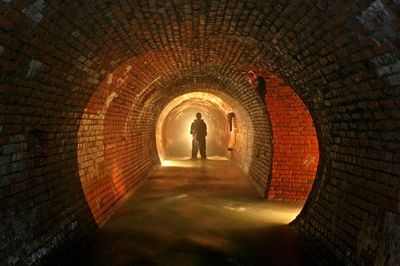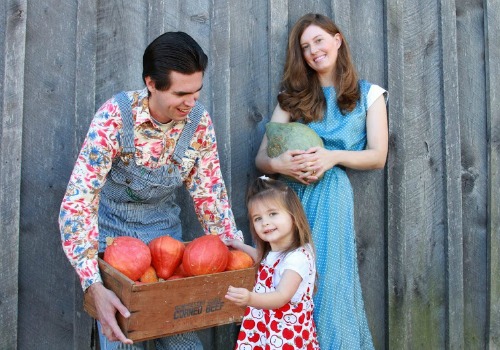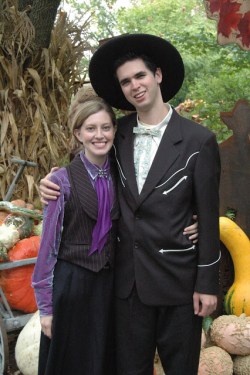
Brian Dunne/Baker Creek Heirloom Seed CompanyThe Gettles.
Emilee and Jere Gettle are an unlikely power couple. Dubbed “The Evangelists for Heirloom Vegetables” by The New York Times, the Gettles run the largest mail-order heritage seed business in the U.S. Their empire includes seed banks in California and Connecticut, Heirloom Gardener magazine, and a pioneer village on their Missouri farm. They host trade fairs and heritage festivals, write vegan cookbooks, and homeschool their 5-year-old daughter, Sasha.
Their lives sound like something from a different era. Raised by homesteading parents, Jere started gardening at 3 and opened Baker Creek Heirloom Seeds at age 17. He met Emilee in 2006, when she interviewed him over the phone about homeschooled kids starting their own businesses — then stopped by a few months later for a visit. “When she walked into the seed store … my heart stood still,” Jere writes of their first meeting. “She was beautiful and elegant, and I knew right away that I wanted to marry her.” And he did — a few months later.
If you don’t already have a lump the size of a Tennessee Dancing gourd in your throat, the family dresses like they’re straight out of a Laura Ingalls Wilder novel. In photos, the whole family can be seen posing in farm fields and seed shops wearing carefully selected, brightly colored vintage clothing. While the look undoubtedly endears them to the press and makes their pioneer village feel authentic, Emilee says the aesthetic is sincere: “I just think older clothes are prettier than some of the modern fashion that’s out there.”
Emilee says her wardrobe is 75 percent vintage or vintage-inspired. Right now, she buys most of her clothing off of eBay or at consignment shops, but she is currently working on an online dressmaking degree and plans on whipping out her sewing machine more this winter. She scours old magazines and patterns and even seed catalogs for insight on how folks used to dress. She crochets in the car and fires off patterns to Coats and Clarks when she reaches an internet connection and her 5-year-old is napping.
It’s heritage and craftiness taken to its logical extreme — an (admittedly eccentric) rejection of most everything industrial and mass-produced. And while we may not all be ready to don pairs of pinstripe overalls, it’s an ideal we can learn from.
I caught up with Emilee as they were putting the finishing touches on their annual seed catalog, getting ready to head to Italy for a slow food event and seed hunting, and getting Christmas presents together (all handmade or artisan-bought, natch) so she can just wrap them up when they return in December.
Q. Why is heritage so important to your family?
A. For the seed aspect, I think it’s really important that we maintain those variety of heirlooms that grandparents and parents passed down to us. One, they have more nutrition than modern varieties do. On top of that, the history. This is how food is supposed to taste. They grew it and it tasted good. It wasn’t “this looks like a tomato but you’re not tasting anything.”
I like that with old-fashioned clothes: They made it and it held up. With [modern] clothing — it looks nice but it’s going to fall apart in a week. These clothes have been around for 30, 40 years and I can still wear them and they aren’t falling apart. I like that time-honored skill went into it.
Q. I have a blouse of my great-grandmother’s that’s over 70 years old. It’s in better shape than a shirt I bought a few months ago.
A. It’s amazing. All those stitches. When they took the time to make it, it was like an art form. They made it to last. Unfortunately now, clothing is like fast food. We sew it fast. It’s produced in a factory. The people aren’t getting paid correctly.
Q. When did you start dressing like this?
A. When I was younger, I liked it but I never felt like it was OK to wear it. It doesn’t always match with what’s currently in style. I would buy stuff and say, “Oh that’s cool. Maybe if I go and reenact somewhere someday.” Once I got married, Jere had a nice stash of vintage clothing and I started pulling out my stuff.
At the farm, we have a dress policy where everything has to look 1950s or before. We have a small building dedicated to just wardrobes for the employees. Whenever we do an event, like when we went to California, we shipped the wardrobe out there. It’s helpful. We had 15,000 people at that event. When people had questions, they knew anyone dressed in this clothing would be the ones with the answers. It’s fairly eye-catching.
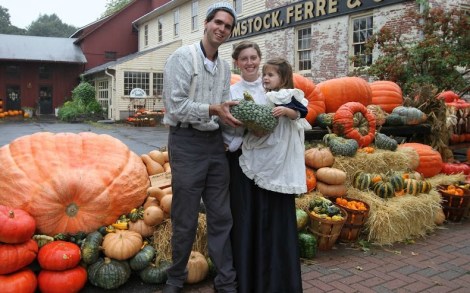
Brian Dunne/Baker Creek Heirloom Seed CompanyThe Gettles outside their Connecticut seed store.
Q. It must be pretty fun going to work there.
A. Different people have different feelings about it. Some people love it and totally get into it. Others are a lot more reserved. We try to find something that will make everyone comfortable. We have quite the variety of clothing. Between all the prints and styles, our closets are not boring.
Q. What was your style like before?
A. Go to Walmart and find something off the rack and say, “Hey this is my style.” It was very Midwestern. Jeans and a button-down shirt or sweater. It was just whatever, basically. My family and I don’t shop at Walmart anymore.
Q. Do you get many questions about your clothing?
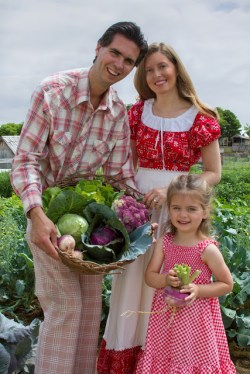
Brian Dunne/Baker Creek Heirloom Seed Company
A. We get a lot of requests even after the catalog [goes out]. Somebody’s wanting to know where to find clothes like ours. Do we sell any of our stuff? Where do we buy it? It’s interesting to see all of the people who contact us for that. As they garden, they are also looking for fashion.
I’m really big into teaching. If someone sees you in an outfit that you feel good about yourself in, they are bound to ask tons of questions. Where did you find that? Did you make it? Do you sew? It’s a conversation piece. Not only is it a way to show people how they can save money and help the environment, but also I’ve made lots of friends just because of conversations being struck up about clothing. It’s a whole ball of wax you can open by trying new things. People realize, “Hey this is cool and I can do it too.” That just keeps the process going.
When I’m working here at the office or when I go to town, I try to tone it down a little. I have some skirts from the ’40s and ’50s. I’ll do that with a button-down top or a cardigan. Our community is a really tiny farm community and it would be like, “Is this for Halloween or what?” But people are pretty used to the old-time clothing.
Q. What’s your favorite era for clothing?
A. I like the 1950s, Rockabilly style, hoops with net crinoline underneath, swing skirts or dresses. I like to stick with country, 1950’s, 1940s pieces — something you would see on The State Fair movie.
Q. In an ideal world, how would people shop and dress?
A. Making sure their dollars went toward fair trade. Being sure what they are purchasing it is something that isn’t harming the environment or they are shopping at thrift stores for the leftovers that people don’t want. If we buy things from the consignment shop or the vintage store, we are helping to save the environment because we are not continually producing more and more and more. We are reusing and repurposing things.
Q. Any advice for people looking to reconnect with their clothing?

Brian Dunne/Baker Creek Heirloom Seed CompanyTouring rooftop gardens in New York.
A. If you really like vintage clothing, don’t be afraid to wear it. Don’t just wear it on special occasions or at Halloween parties. If you feel good about yourself in it, it’s great.
Take the time to learn how to sew. It doesn’t have to be a whole lot. Even if you can learn some embroidery, embellish some clothes you have. Try to reconnect with how clothes are made.
If you’re not artistic, don’t be afraid to pick something up. For most people there is something out there that they will really enjoy. Just like food varieties we are trying to save, a lot of these craft guilds are dying because people think “my life is too busy” or “I’m not artistic and I can’t do it.”
Go to a guild meeting, take some classes, go to craftsy.com and learn a few things in the privacy of your home this winter. It will help you feel more confident to branch out and to try more things. When people aren’t afraid that they aren’t artistic, then they aren’t scared to branch out more in their closet either. It reflects their personality by what they are wearing.
I love New York City but sometimes I go there in the winter time and everyone is wearing black. There are more colors in the rainbow. I might be on the opposite extreme, but still. Add some color. Learn, don’t be afraid, and try something new. Have fun with it.
